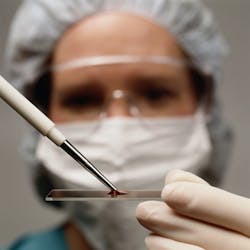Medical laboratory safety management
Lab safety is an important and critical component to the success of any medical laboratory. Professional biosafety practices are impacted by biological, chemical, radiological, fire, and electrical hazards. The most common threats to laboratory safety include improper use (or lack of use) of personal protective equipment (PPE), failure to follow protocols for an appropriate chemical hygiene plan (CHP), and inappropriate use of biological safety cabinets (BSCs) appropriate to the work, and potential technician exposure.
In the early days of laboratory research, scientists conducted their work using practices that we would likely raise our eyebrows at today. Unfortunately, these work practices resulted in many scientists getting sick, and in some cases dying from infections they acquired in the laboratory. Sulkin and Pike historically reported a total of 1,342 laboratory-related infections (LAIs) with 39 deaths out of 5,000 responses to a questionnaire sent out to laboratory professionals.1 They discovered that 72 percent of the bacterial cause of LAIs were caused by Brucella spp, Mycobacterium tuberculosis, Francisella tularemia, and Salmonella typhi. Not all of the infections involved scientists; others included students, animal caretakers, and janitors. More recently in 2007, the Centers for Disease Control and Prevention reported 916 potential exposures that could result in LAIs and that a higher risk of exposure for lab personnel was found in more than 200 bed inpatient facilities than smaller clinics.2
Protecting scientists
The BSC has grown to become one of the most effective primary safety devices used in a laboratory today, protecting not only the worker from the product they are working on, but also protecting the product from the worker. The need to protect scientists and other clinical laboratory staff began to take shape in the beginning of the 20th century when Robert Koch constructed the first biocontainment device after he recognized that germs could be floating in air.3 In 1943 the first dedicated device, which we now recognize as a BSC, was described where the exhaust air vented through a furnace that was used to sterilize the air.3 Later the high efficiency particulate air (HEPA) filter was developed as part of the Manhattan Project and, when incorporated into the BSC, greatly enhanced the safety capability of the BSC. The designs and safety capabilities of the BSC and HEPA filter have continued to evolve and include construction out of stainless steel, a glass sash, and many other features seen on today’s BSCs.
Also critical to management of employee safety in the clinical laboratory is use of PPE, which is standard in the clinical laboratory setting. Whether drawing a patient’s blood or working up blood or other body samples, the key factor is knowing the environment that you are exposed to. If you are a technician working at a computer entering quality control or results from a completed crossmatch, you may not need to be concerned as much about PPE. However, what if the technician is using a computer in the main laboratory room that is shared with other staff? For example, a 2014 study of safety measure compliance investigated “the use of personal protective equipment (PPE) and compliance to the code of conduct.”4 When asked if it was important to use gloves with human samples, 96.3 percent marked yes. However, when asked if they wear gloves as part of their daily routine, only 38.7 percent marked always, with 27.2 percent marking often, and 32.7 percent marking sometimes. The most common answers marked for not wearing gloves are “Lack of habit” (18.4 percent) and “They interfere with my work” (32.3 percent). Additionally, the question “I wash my hands before and/or after using gloves”4 generated 75.1 percent answering always, 16.1 percent often, 7.8 percent sometimes, and 0.9 percent never. An additional 2014 study of standard knowledge of blood-borne pathogen precautions identified differences of PPE use and knowledge between physicians and medical laboratory staff (MLS).5 While general knowledge of standard precautions was found in 76.2 percent of the physicians and 67.6 percent of the MLS surveyed, reported use of PPE was seen in 100 percent of the MLS and 35 percent of the physicians.5
Risk assessments
Training and keeping up with PPE requirements are benchmarks for medical laboratory and research staff. Not all circumstances are going to warrant the same PPE requirements; PPE can be truly effective only when used correctly in the prescribed conditions.6 Implementation of a risk assessment for all procedures performed in the laboratory enables staff to ensure mitigation of hazards and exposure risks in the clinical laboratory. Risk assessments are typically performed by developing a worksheet including the main and sub-tasks in question. This worksheet is used to identify hazards and assess the risk level of a task. A laboratorian can then ensure that hazards are mitigated and appropriate PPE implemented. Of course, the need for PPE varies widely depending on the task at hand.
If you are working on a computer you may not need a lab coat if you are in an office that is never used for human samples. If you are going to a clinic to assist in collecting bone marrow spicules from a bone marrow biopsy/aspiration, would you use PPE? Of course, you would don gloves, lab coat, eye protection, and additional PPE if indicated by the procedure being performed. Additionally, what if you are going to draw blood from a patient and see that the patient is wearing a face mask? As professionals it is proper to don the appropriate PPE when the situation indicates. The time to take the extra step to don PPE versus assuming it’s not needed saves both the laboratorian risk and the patient time and grief. Just as customer service is important to clinical laboratory, the implementation of biosafety programs such as a CHP is critical to safety of the patient and laboratory staff.
One of the most dangerous aspects in the medical laboratory comes from chemicals. The Occupational Safety and Health Administration (OSHA) fact sheet identifies the required elements in a laboratory CHP.6 While the OSHA laboratory safety chemical hygeine plan doesn’t cover every possible contingency, it does identify required CHP elements:7
- Standard operating procedures relevant to safety and health considerations
- Appropriate use of STET and hygiene practices
- Requirement that fume hoods and other protective equipment are functioning properly
- Information to be provided to lab personnel working with hazardous substances
- Circumstances under which a procedure or activity is reviewed and approved before implementation
- Designation of personnel responsible for implementing the CHP
- Provisions for additional worker protection for work with particularly hazardous substances.
The main thrust of the CHP is to identify risks for laboratory staff, develop standard practices that remove or reduce the risk to the staff, designate a person responsible to manage this process, and describe additional protective measures when working in an environment of higher risk. This plan is to maintain appropriate training and overview of the process. Risks for laboratory staff members are consistently evolving as new techniques and processes are implemented. The identification of a key trainer is critical to maintain the CHP and update it as needed. Without management of this process, you could end up with an unacceptable plan that describes procedures for analyzers used several years ago.
Many laboratories are similar in their testing capabilities; however, some tests require more specialized biosafety equipment such as a fume hood. A fume hood is classified as a ventilated enclosure to remove fumes, while a BSC is designed to protect the worker and is more commonly used with protection from infectious disease or toxins. A laboratory fume hood may be considered the primary protection for lab workers,8 but that depends on the work environment. What if your lab test load or capabilities are roughly the same compared to other local hospitals, but your blood bank specializes in irradiated products and prepares them for all the other laboratories in your area? These are aspects to consider when designing a solid CHP for your workspace.
The application of biosafety precautions is of utmost importance to maintaining the safety of the laboratory test floor as well as protecting the employees. Use of BSCs and HEPA filters has contributed to the efficiency and safety of laboratory testing as a discipline. Appropriate use of PPE based upon sound risk management principles ensures that you and your employees are protected. As part of the very nature of their work, medical laboratory staff face many challenges. However, with the use of appropriate biosafety measures, a safe, effective environment helps them meet these challenges head on!
REFERENCES
- Sulkin SE, Pike RM. Survey of laboratory-acquired infections. Am J Public Health Nations Health. 1951;41(7):769–781.
- Hearn T. Addressing the continuing threat of laboratory-acquired infections. Retrieved from https://wwwn.cdc.gov/cliac/pdf/Addenda/cliac0908/Addendum%20E.pdf.
- Buie J. Evolution of biological safety cabinets. Retrieved from http://www.labmanager.com/lab-product/2011/06/evolution-of-biological-safety-cabinets#.W22jF7gnaUk.
- Dukic K, Zoric M, Pozaic P, et al. How compliant are technicians with universal safety measures in medical laboratories in Croatia? – A pilot study. Biochem Med (Zagreb). 2015;25(3):386– doi: 10.11613/BM.2015.038.
- Ndu AA, Arinze-Onyia SU. Standard precaution knowledge and adherence: Do doctors differ from medical laboratory scientists? Malawi Med J. 2017;29(4):294– doi: 10.4314/mmj.v29i4.3.
- Villano JS, Follo JM, Chappell MG, Collins MT Jr. Personal protective equipment in animal research. Comp Med. 2017;67(3):203–
- Occupational Safety and Health Administration. Laboratory safety chemical hygiene plan (CHP). OSHA Fact Sheet. Retrieved from https://www.osha.gov/Publications/laboratory/OSHAfactsheet-laboratory-safety-chemical-hygiene-plan.pdf.
- University of Minnesota Environmental Health and Safety. IT characterization facility: chemical hygiene plan. Retrieved from http://www.charfac.umn.edu/safety/chp.html.
About the Author

Lt Col Paul R. Eden, MT(ASCP), PhD, USAF (retired)
has 24 years of laboratory experience managing both clinics and hospital laboratories including over six of years of applied research. He is also serving as Adjunct Assistant Professor, Pharmacology & Toxicology, Wright State University, Ohio.
